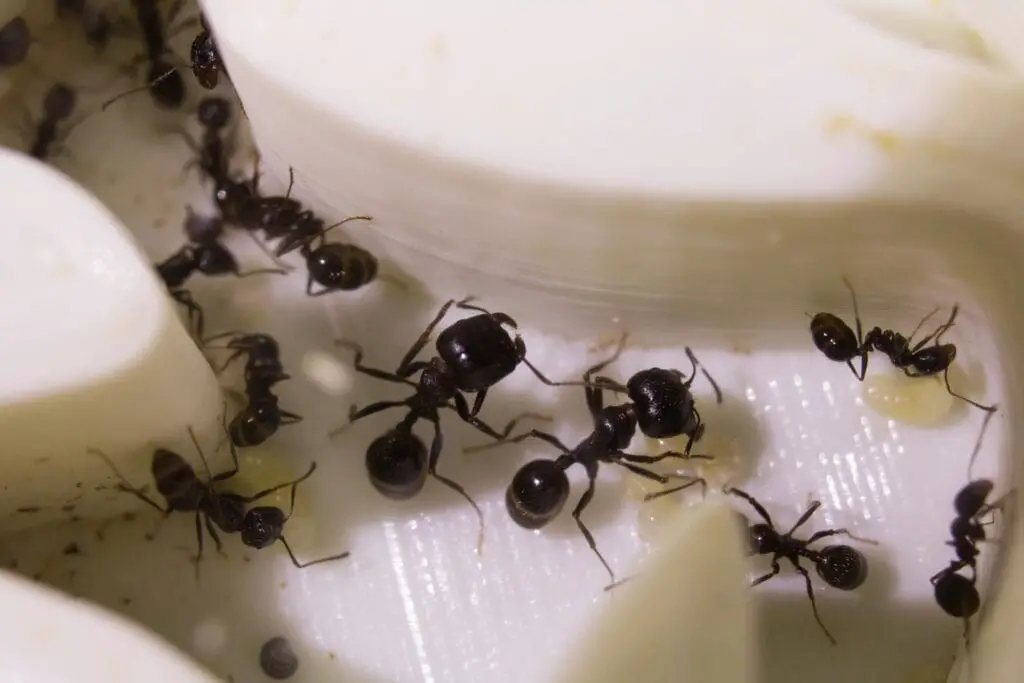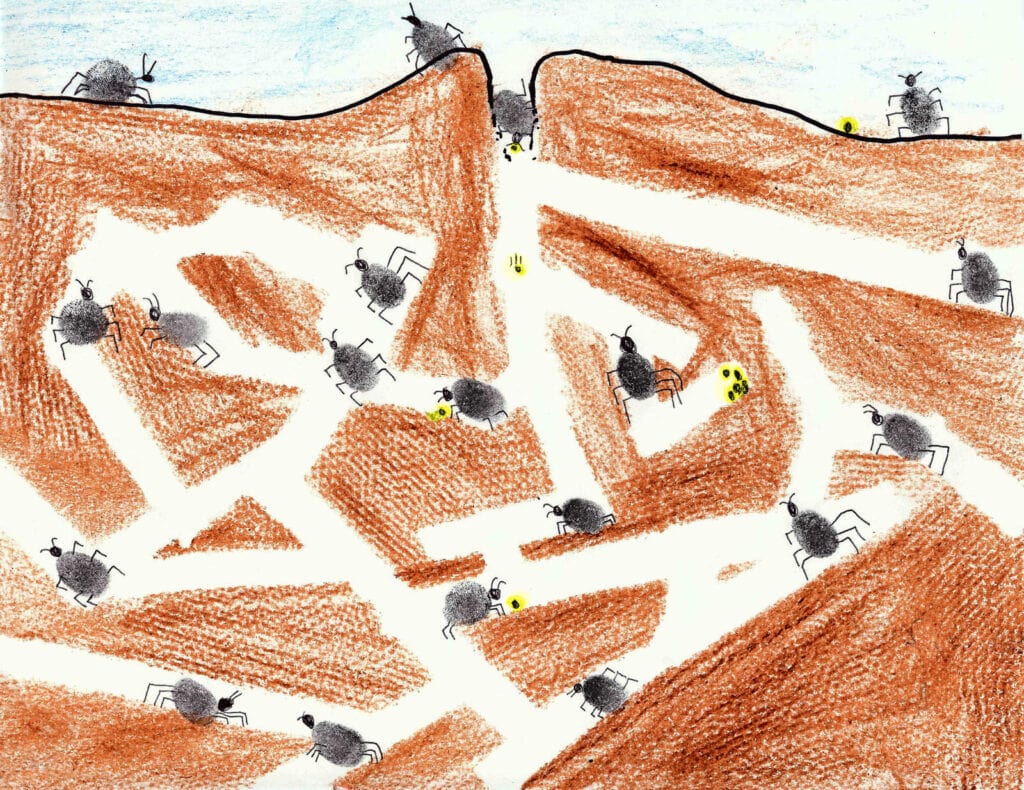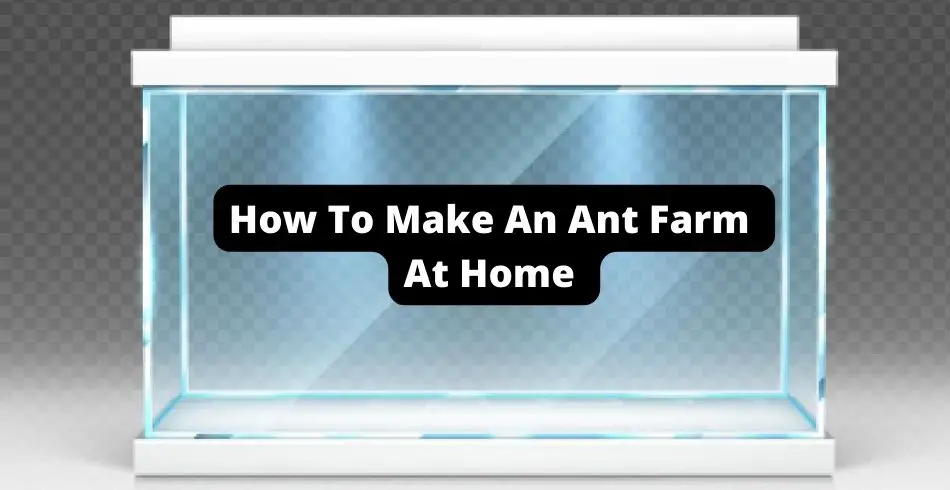The ant’s farm is where all the magic happens.
Why else would they spend all their time in there?
We will be going over a full guide on building your own ant farm at home – tips, tricks, and how-tos that get you moving in the right direction.

While there are some creative ways to build an ant farm, one of the easiest ways to get started is to just purchase one. We went over that here in this buying guide.
What Exactly Is An Ant Farm?
Some of the most fascinating aspects of ants and their group interactions can only be observed when they are researched and watched on constructed farms.
Have you ever wondered what was going on underneath the soil when watching ants enter and exit their farm?
It’s difficult to tell from the outside.
And let’s be honest, the ants won’t be too happy if you dig up into their nest.
That’s why we think the best way to see what ants do in those cool mounds is to build your own ant farm, to make them believe they are beneath the ground!
This may be accomplished by placing them on an ant farm.

Once your ant farm is built, you’ll probably need a full ant-keeping guide to get started.
We have that here in this guideline Getting Started with Keeping Ants.
What Do I Need to Build my Own Ant Farm?
Ant farms with transparent, flat walls and a small layer of dirt wedged in the middle, allowing the ants to dig a tunnel in the soil, are the best.
They should also have a place towards the top for the ants to look for food.
Finally, since ants are excellent escape artists, a great ant farm should be well-sealed to avoid ants from fleeing.
Finding ants in an area where they aren’t intended to be isn’t enjoyable.
Ant farms occur in a variety of forms and sizes, as you can see from the pictures we have here.
Though, make sure you’re putting the right items in there, a cactus may not be best!

Make sure you use something like a large jar and construction paper (use a utility knife to poke some holes in the top) to allow your ants some air.
[amazon box=”B08JLNHHZX”]
Putting Together an Ant Farm
When you make an ant farm, you will usually want this to be put into some type of container.
While our most simple design includes a small jar and only about 20 minutes, Some of the big tanks (also known as a formicarium) are easy to build and allow you to watch your ant colony up close with really unique and awesome designs.
Though, this could also work with a larger jar.
Four Easy Farms to Build (Guide)
These little farms are handy for studying and watching some of your favorite ant species, let’s get your ant farm started!
Farm Design 1 (The Jar)
Materials needed:
- 1 Large Jar
- 1 Smaller Jar
- Sand or Dirt
- Jar Lid
- Sharp Knife
Building The Classic Ant Farm
The first thing you’re going to want to do to create your new ant farm is to place the smaller jar into the larger jar with the lid on tight.
This will allow the dirt to be squished up against the outer walls of the larger mason jar.
A soil and sand mixture does work (dirt mixture), but make sure you double-check what type of ants you’re after, as some do much better with nutrients in the soil (dirt).
Remember to leave some empty space so you can always give a few drops of honey or sugar water, and to ensure your ants have enough air.
I like to poke tiny holes in the top of the lid of the mason jar. When I do poke holes, I make sure to poke small holes, as the worker ants will be moving around the class ant farm rapidly, and will escape if allowed.
Woohoo! You now have an ant farm where your ants can build tunnels and thrive!
Here’s a great photo my daughter drew, to illustrate this

Your ant farm will survive for much longer if you do find a queen ant and remember to avoid direct sunlight and areas in the house that are too cold.
Farm Design 1a (No Water Moat)
Some ants, like the typical ‘greenhead‘ (Rhytidoponera Metallica) and its cousins, do not require a water moat to prevent them from fleeing.
This is due to the fact that only the males of these ants have feet capable of climbing clean vertical glass.
The glass or plastic ‘fence’ in this Farm layout will readily trap the workers, who will generally stop the males from departing.
Materials needed:
- Glass or plastic tray/dish with smooth, vertical sides
- Wooden frame
- Soil
- A pane of glass to fit over the frame
- Opaque cover e.g. thick paper, plywood, etc.
Building The 1a Ant Farm
A fence can be made out of a huge glass or polished plastic tray, or a container with sidewalls.
Place a little layer of dirt in the center of the tray inside a basic wooden frame to offer a nesting area for the ants. To enable the ants to exit for grazing, the frame requires an exhaust pipe.
The farm is then completed by placing a pane of glass over the dirt and covering it with an invisible cover.
When the farm is not being inspected, it should be closed to mimic normal dark circumstances.
Farm Design 1b (Climbers)
Sugar ants (Camponotus species) and many other types of ants may scale glass or plastic fences, hence a moat surrounding the colony is required.
Materials needed
- Farm Design 1a
- A piece of heavy wood, of the same dimensions as the Farm
- Paint
- Water, to form a moat
- Building the nest
Constructing the nest
Attach the wooden board (which includes the topsoil and glass) from Farm Design 1a to a piece of sturdy wood.
The tray is then filled with water until it reaches the wood’s edge, making a trench around the Farm. To avoid waterlogging, the wood should be coated.
Farm Design 2
Unless a stopper is eliminated from this type of Farm, the ants will be unable to exit to forage.
Materials needed
- Wooden strips to make up the frame
- 2 panes of glass
- Nails or waterproof glue
- Cotton wool/nylon stocking plug
- Soil or sand
- Opaque cover e.g. thick paper, plywood, etc.
Building the Farm
A slender, rectangular hardwood frame 15 cm to 30 cm long and comparable in breadth can be used to make a glass farm. The frame should be made out of 1.5 cm thick and 1.5 cm broad pieces of wood.
The frame divides two panes of glass, creating a hollow where the ants will build their farm.

The frame is held together with fine screws or waterproof glue, after which the glass panes are fixed in place.
To accommodate the ants and nourishment, a 2.5 cm gap should be left in the frames at a corner.
Cotton wool folded in a piece of nylon stockings can then be used to seal the hole.
This enables some air into the farm while keeping the ants from tugging the wool. After that, fill the cavity with soil or sand.
This should be dispersed thinly to prevent the ants from digging and hiding.
If the burrowing activity of the ant being researched is to be seen, the wooden strips should have the same width as the diameter of the ant’s tunnels, so that no dirt layer adheres to the top pane of glass.
To replicate subterranean circumstances, the farm is darkened with an opaque cover made of thick paper, plywood, or a suitable item cut to the size of the glass. For the sake of observations, this has been deleted.
Materials needed:
- Wooden board (60 cm x 30 cm)
- 4 x 10 cm long screws
- 4 x bottle tops
- Naphthalene flakes (or petroleum jelly)
The table’s construction
Drive 10 cm long screws a short way into the bottom of a wooden board to make a tiny table (approximately 60 cm x 30 cm in size).
To reduce vibration, these legs can be placed on a substantial wood or other foundation. Impale upturned bottle tops on the screws before placing the board in place to avoid the ants from escaping.
Naphthalene is then injected into the bottle caps (Petroleum jelly, or other greases, may be tried instead of naphthalene).
Regularly refill the naphthalene.
This can hold a farm of virtually any design, however, farm Design 2 with a rigid foam insulation base rather than glass will be the most convenient.
Is Ant Keeping The Right Hobby For You?
If you’re going to collect ants for your ant farm, make sure you get a decent mix of adults, larvae, and pupae.
Finding the queen, who is several times greater than the other ants, is also critical.
Also, if you do decide to do this, make sure your ants get some fresh air every so often! Everyone needs a little sunshine.
Be careful you don’t make a mistake and pick the wrong type of ants, like fire ants.
(Here’s a cheat code…save yourself hours)
[amazon box=”B07W3NLRVG”]
